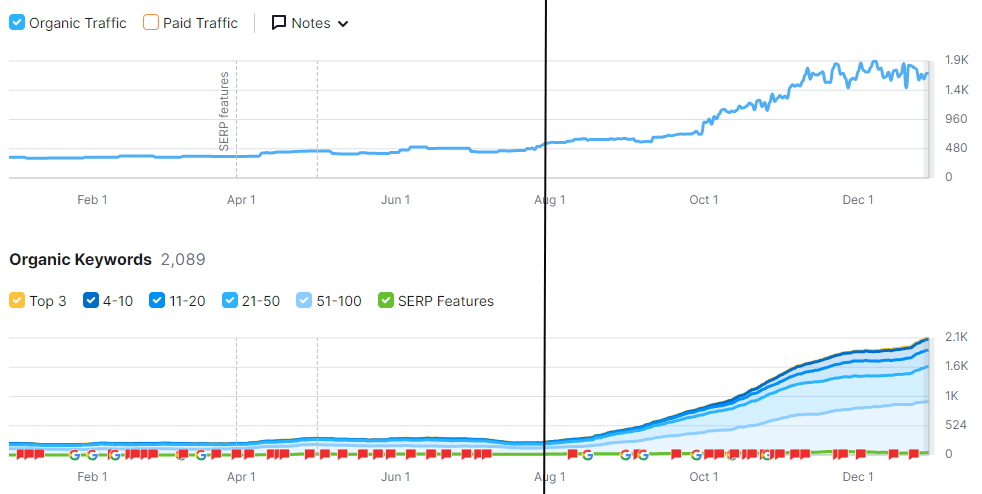
SEO consistency refers to the practice of implementing and maintaining a steady and coherent approach to search engine optimization (SEO) efforts over time. It involves regularly applying best practices, making updates as needed, and ensuring that various aspects of your website align with SEO guidelines consistently.
Here is a screenshot of our effort with a client, beginning in the August 2023 timeframe, to produce keyword-focused content, embed a link-building strategy, and continue to optimize their website for keywords. As you can see, SEO consistency led to 810% growth in organic keywords (from 220 to 2,000), and an increase of 254% in monthly organic traffic (from 452 to 1,600). In addition, this client’s domain authority increased from 9 to 13 and their backlinks increased 408% (from 1,300 to 6,600).


Here are the key elements of SEO consistency:
Content Creation and Publishing:
Consistently produce high-quality, relevant, and valuable content. Regularly updating your website with fresh content signals to search engines that your site is active and authoritative.
Keyword Optimization:
Systematically incorporate relevant keywords into your website’s content, meta tags, headers, and other on-page elements. This helps search engines understand the context and relevance of your pages.
Technical SEO:
Conduct regular technical SEO audits to identify and address issues like broken links, crawl errors, and site speed. Consistently maintaining a technically sound website enhances its performance in search engine results.
Link Building:
Build a strong and diverse backlink profile over time. Acquiring high-quality, relevant backlinks consistently signals authority and relevance to search engines.
User Experience (UX):
Prioritize a positive user experience by maintaining a user-friendly website structure, easy navigation, and fast page loading times. Consistent UX improvements contribute to higher user satisfaction and search engine rankings.
Mobile Optimization:
Ensure your website is optimized for mobile devices consistently. With the increasing use of smartphones, search engines prioritize mobile-friendly sites in their rankings.
Social Media Presence:
Maintain a consistent and active presence on social media platforms. While social signals may not directly impact rankings, a strong social presence can indirectly contribute to increased brand visibility and traffic.
Local SEO:
For businesses with a local presence, consistently update and optimize business listings on online directories. Ensure accurate NAP (Name, Address, Phone number) details across platforms for local SEO consistency.
Analytics and Monitoring:
Regularly monitor and analyze SEO performance using tools like Google Analytics. Consistent analysis helps in understanding the effectiveness of your strategies and making informed decisions for improvements.
Adaptation to Algorithm Changes:
Stay informed about search engine algorithm updates and adjust your strategies accordingly. Adapting consistently to algorithm changes helps maintain or improve search rankings.
Regular Content Audits:
Conduct regular content audits to evaluate the performance of existing content. Identify outdated or underperforming content and either update it or remove it. This ensures that your content remains valuable and aligns with current search intent.
Schema Markup Implementation:
Consistently apply schema markup to provide search engines with additional context about your content. This can enhance the appearance of your snippets in search results, potentially leading to higher click-through rates.
Consistent Branding and Messaging:
Maintain a consistent brand image and messaging across all online platforms. Consistency in branding builds brand recognition, which can indirectly impact user trust and search engine rankings.
Regular SEO Training and Education:
SEO is a dynamic field with constant updates. Ensure your team stays informed about the latest SEO trends and updates through regular training sessions. This ongoing education helps maintain a high level of expertise within your organization.
Accessibility Compliance:
Consistently ensure that your website is accessible to all users, including those with disabilities. This involves maintaining compliance with accessibility standards and regularly testing your website for accessibility issues.
Security Measures:
Implement and maintain strong security measures for your website. Regularly update software, use secure protocols (HTTPS), and protect against malware. A secure website is favored by search engines and contributes to user trust.
International SEO Consistency:
If your website has an international audience, maintain consistency in your international SEO efforts. This includes using hreflang tags to indicate language and regional targeting, ensuring consistent content localization, and optimizing for local search engines.
Consistent Local Citations:
For local businesses, maintain consistent business information (NAP) across online directories, review sites, and other local citation sources. Inconsistent information can lead to confusion among users and negatively impact local search rankings.
Strategic Use of Multimedia:
Consistently integrate multimedia elements like images, videos, and infographics into your content. Optimizing multimedia for search engines can enhance the overall user experience and contribute to better search rankings.
Ethical SEO Practices:
Adhere to ethical SEO practices consistently. Avoid engaging in black hat SEO techniques that can lead to penalties. Building a sustainable online presence involves playing by the rules and focusing on long-term success.
Voice Search Optimization:
With the rise of voice-activated devices and digital assistants, consistently optimize your content for voice search. This involves understanding and incorporating natural language queries that users might use when speaking rather than typing into a search engine.
Regular Competitor Analysis:
Conduct regular competitor analysis to stay aware of industry trends and understand how your competitors are approaching SEO. Consistent monitoring of your competitive landscape allows you to identify new opportunities and refine your strategy accordingly.
Consistent Local Community Engagement:
Actively engage with your local community online through forums, social media groups, and other platforms. This not only contributes to your brand’s local presence but also creates opportunities for local link building and positive online reviews.
Featured Snippet Optimization:
Consistently work towards earning featured snippets for relevant queries. Structure your content in a way that is likely to be selected for featured snippets, as they can significantly enhance your visibility in search results.
Regular Backlink Audits:
Conduct regular audits of your backlink profile to identify and address any low-quality or toxic backlinks. Consistently monitoring your link profile helps in maintaining a healthy link profile, which is crucial for SEO success.
Structured Data Markup Consistency:
Implement and update structured data markup consistently. This provides search engines with additional information about your content, which can result in rich snippets and improved visibility in search results.
Long-Tail Keyword Optimization:
Consistently optimize your content for long-tail keywords. These specific and niche phrases often have lower competition and can attract highly targeted traffic to your website.
Regularly Updated and Relevant Meta Data:
Keep meta titles and meta descriptions consistently updated and relevant to the content on each page. This not only helps search engines understand your content but also entices users to click through to your website.
Consistent Social Sharing Strategy:
Develop a consistent strategy for sharing your content on social media platforms. Regularly sharing valuable content on social channels can drive traffic, increase brand awareness, and indirectly impact search rankings.
Frequent Testing and Optimization:
Conduct A/B testing and other optimization experiments regularly. Whether it’s testing different calls-to-action, layouts, or content structures, consistent testing allows you to identify what works best for your audience and adjust your strategy accordingly.
Consistent Monitoring of Core Web Vitals:
With search engines increasingly considering user experience factors, consistently monitor and improve Core Web Vitals. These metrics include aspects like page speed, interactivity, and visual stability, all of which contribute to a positive user experience and can impact search rankings.
Seasonal SEO Optimization:
If applicable to your business, consistently optimize your website for seasonal trends. This involves adjusting your content, keywords, and promotions to align with specific seasons or events, ensuring relevance throughout the year.
Regularly Updated XML Sitemap:
Keep your XML sitemap up to date by regularly adding new pages and removing outdated ones. This helps search engines crawl and index your site more efficiently.
Consistent Local SEO Efforts for Multiple Locations:
For businesses with multiple locations, maintain a consistent approach to local SEO across all locations. This includes creating individual landing pages, optimizing local citations, and managing reviews consistently for each location.
Dynamic Content Updates:
Implement dynamic content updates to ensure that your website remains relevant to changing user preferences and search trends. This might involve updating trending topics, adjusting content formats, or incorporating emerging keywords.
User-Generated Content Moderation:
If your website features user-generated content (such as comments or reviews), consistently moderate and manage this content. This not only enhances user engagement but also maintains a positive online environment, which can impact your site’s reputation.
Consistent Link Reclamation:
Regularly monitor for lost or broken backlinks and implement strategies for link reclamation. Consistently maintaining a strong backlink profile is crucial for SEO success.
Up-to-Date SEO Tools Utilization:
Stay informed about the latest SEO tools and technologies. Consistently using up-to-date tools can enhance the efficiency of your SEO efforts, from keyword research to analytics tracking.
Regularly Updated Knowledge Base:
Keep your team’s SEO knowledge up to date by encouraging ongoing learning. This might involve attending industry conferences, webinars, or training sessions to stay informed about the latest trends and best practices.
Consistent Social Listening:
Actively engage in social listening to understand what your audience is saying about your brand and industry. Consistent monitoring of social conversations can provide insights that influence your content strategy and overall online presence.
Strategic Internal Linking:
Implement a consistent strategy for internal linking. This helps distribute link equity across your site, improves navigation for users, and signals to search engines the hierarchy and relevance of your content.
Regularly Updated Knowledge Base:
Keep your team’s SEO knowledge up to date by encouraging ongoing learning. This might involve attending industry conferences, webinars, or training sessions to stay informed about the latest trends and best practices.
Consistent Podcast and Video Optimization:
If you produce podcasts or videos, consistently optimize them for search engines. This involves using relevant keywords in titles and descriptions, providing transcripts, and ensuring that multimedia content aligns with your overall SEO strategy.
Blockchain and Web 3.0 Considerations:
As technology evolves, stay attuned to emerging trends like blockchain and Web 3.0. Consistently adapting your strategy to incorporate these technologies can position your website for future SEO success.
Consistent HTTPS Implementation:
Ensure your website consistently uses HTTPS. Search engines prioritize secure websites, and HTTPS is considered a ranking factor. Regularly check and update security certificates to maintain a secure connection for users.
Consistent PR and Outreach Efforts:
Engage in consistent public relations and outreach efforts to build brand mentions and backlinks. This can contribute to your site’s authority and visibility in search engine results.
Consistent Mobile App Optimization:
If you have a mobile app, consistently optimize its visibility in app stores. This involves updating metadata, responding to user reviews, and incorporating relevant keywords to improve discoverability.
Regularly Updated SEO Documentation:
Keep your SEO documentation up to date. This includes guidelines, processes, and best practices that your team follows. Consistently revising and improving these documents ensures that everyone is aligned with the latest strategies.
Consistent Email Marketing Optimization:
If you utilize email marketing, consistently optimize your campaigns for user engagement and relevance. While not directly tied to search rankings, a engaged audience can indirectly contribute to website traffic and brand authority.
Continuous Reputation Management:
Consistently monitor and manage your online reputation. Respond to reviews, address customer concerns, and actively participate in online discussions related to your industry. A positive online reputation can influence user trust and indirectly impact search rankings.
Remember that SEO consistency is a multifaceted approach that encompasses a wide range of factors. By maintaining a steadfast commitment to these practices, you’ll be better positioned to adapt to changes in the digital landscape and achieve long-term success in search engine rankings.

Our mission is to help battery and energy industry companies quickly and effectively reach their revenue goals.
We’ll provide you with a complimentary digital marketing audit so that you can quickly learn how to optimize your digital presence. Just fill out the form below: